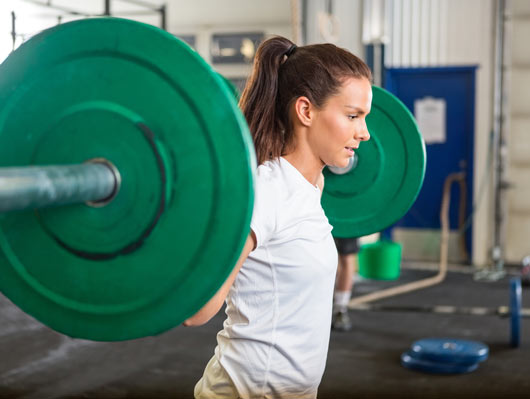UPDATED October 26th, 2017
We all know that staying healthy and fit contributes to our physical as well as mental wellbeing. And many of us are dedicated and regular exercisers. But just walking, or just running, or just lifting weights isn’t enough to attain overall fitness. There are five primary components of fitness that account for one’s overall fitness, and your workout routine needs to consider all of them. Want to know whether you really are fit? Here’s a look at the five components of fitness, and why they’re so important:
1. MUSCULAR STRENGTH
The maximum force a muscle can exert against resistance (e.g., lifting weights) in a single contraction determines one’s absolute muscular strength. Pretty simple concept, huh? Measuring muscular strength is fairly straightforward. Subjects engage a target muscle group by executing a specific movement against resistance, increasing weight until only one repetition can be performed.
Popular measurement techniques tend to incorporate compound movements such as the bench press or squat. Compound movements rely on a concerted effort of two or more muscle groups to move multiple joints through a range of motion. As opposed to isolated (single joint) movements, compound movements apply to most real world actions and better indicate uniform strength throughout the body.
Most of us know that increased muscular strength translates to increased muscle size—hence the popularity of bodybuilding and powerlifting—but what are other benefits aside from hulk-like strength and Schwarzenegger-like guns?
Turns out, within the structure of our anatomy, muscles attach to bones via tendons and bones attach to bones via ligaments. Because of biomechanics, resistance training strengthens the entire anatomical system (i.e. muscles, tendons, ligaments and bones). Other positive gains include improved posture, decreased risk of injury and easier gross movements.
Read Related: 7 Ways for Moms to Set & Keep Realistic Fitness Goals
2. MUSCULAR ENDURANCE
By definition, muscular endurance refers to the body’s ability to sustain repeat contractions against resistance for an extended period of time without experiencing fatigue. Although muscle activation inherently requires some degree of muscular strength, muscular endurance is necessary to perform movements like running on a treadmill or shoveling snow. Measuring muscular endurance is reasonably simple—unless you’re the test subject.
As far as measuring goes, the same compound movements used to observe muscular strength can be used to determine muscular endurance, but repetition numbers differ significantly. If strapped for time, counting the number of repetitions within a set amount of time will work. However, the best way to determine one’s endurance threshold is by counting the number of repetitions required to induce total muscle fatigue (failure).
Benefits of good muscular endurance overlap with those of both muscular strength and cardiorespiratory fitness. For example, people who swim or participate in crossfit engage in both endurance and strength based training, which improves all components except flexibility.
3. CARDIORESPIRATORY FITNESS
Defined by the cardiovascular and respiratory systems’ joint capacity to deliver oxygen-rich blood to skeletal muscles during sustained exercise, cardiorespiratory fitness plays an integral role in overall muscle efficiency. For example, aerobic exercise enlarges and strengthens the heart by forcing it to work harder. A stronger heart will pump more blood than a weaker heart with each contraction.
Maximal oxygen uptake can be measured through a VO2 max test. Unique to each participant, the test measures the body’s maximum capacity to both transport and use oxygen during incremental exercise (expressed in L / min).
Increased cardiorespiratory fitness can reduce the risk of heart disease, lung cancer, type II diabetes and strokes. Plus, exercising the associated systems releases endorphins, which cause feelings of euphoria—so dust off that stationary exercise bike and get spinning.
4. FLEXIBILITY
Referring to the range of motion available at a joint, there are two types of flexibility: static and dynamic. Static flexibility refers to the range of motion of a particular joint when the body is not moving, whereas dynamic flexibility refers to the range of motion of a particular joint during movement. Static stretching can be used to promote overall flexibility, improving dynamic flexibility as a result. Measuring one’s flexibility is simple; you can test yourself by performing basic static stretches.
Here’s the laundry list of the benefits of flexibility: improved exercise performance, decreased injury risk, reduced muscle soreness, improved posture, reduced risk of lower back pain, improved blood flow and improved muscle coordination.
5. BODY COMPOSITION
Body composition, in terms of fitness, refers to the percentage of fat, bone muscle and other lean tissues that consist of the body. There are many techniques used to measure one’s fat tissue composition, allowing the subject to deduct the rest as lean tissue. Here are a few popular methods…
• Gun Calipers: The most popular method, gun calipers are used by measuring the thickness of subcutaneous fat in various regions of the body. The measurements are then placed into an equation and the results are estimated within a margin of error.
• Bioelectrical impedance (BIA): BIA uses the resistance of electrical flow through the body to estimate body fat.
• Air Displacement Plethysmography (ADP): The subject is placed into an egg-like structure that measures the density of their body. The denser readings mean lower body fat.
For the average adult male, a healthy range of body fat is between 10-20%, for females it’s a bit higher around 17-31%. Regular exercise can reduce body fat composition and increase lean body tissue mass. Benefits include improved triglyceride levels, a lowered risk of cardiovascular disease and a healthier look.












